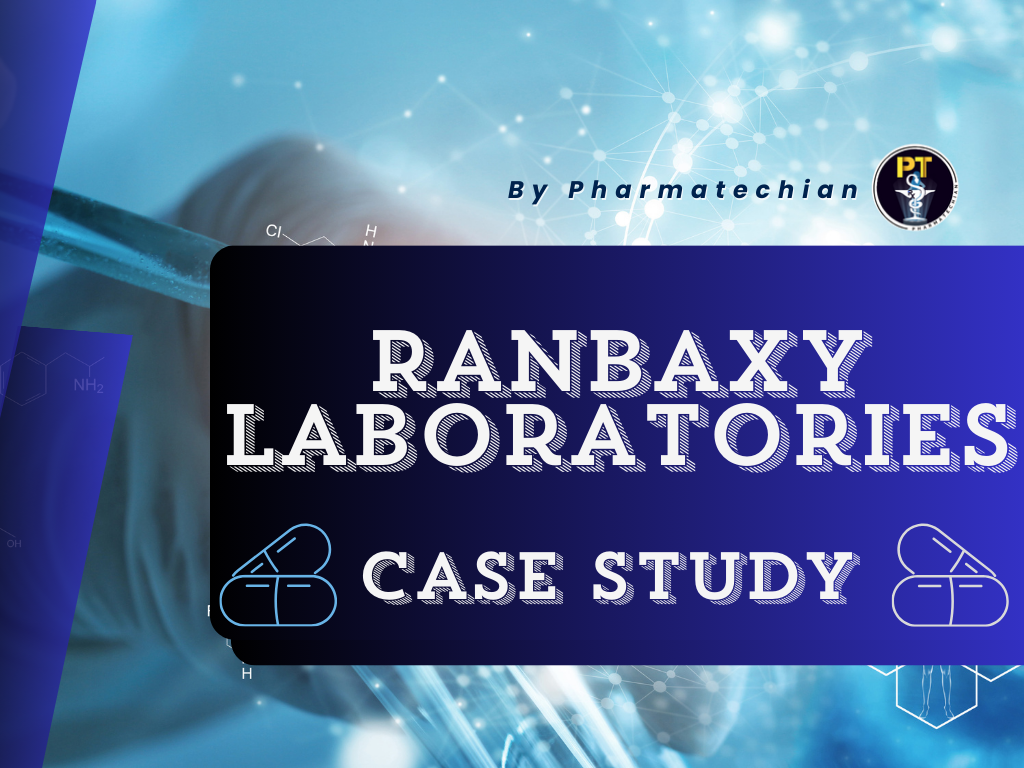
1. Growth and Expansion Strategy of Ranbaxy Laboratories
Overview:
Founded in 1961 by Ranbir Singh and Gurbax Singh, Ranbaxy Laboratories grew to become one of India’s largest pharmaceutical companies before being acquired by Sun Pharmaceutical Industries in 2014. Ranbaxy’s growth strategy was characterized by aggressive international expansion, strategic mergers and acquisitions, and significant R&D investments.
Key Milestones:
- 1961: Establishment of Ranbaxy Laboratories.
- 1977: First major international expansion into the Southeast Asian market.
- 1993: Became the first Indian company to export branded generics to the U.S.
- 2006: Achieved annual sales of over $1 billion.
- 2008: Acquired by Daiichi Sankyo, a Japanese pharmaceutical company, marking a significant shift in its global strategy.
- 2014: Acquired by Sun Pharmaceutical Industries, consolidating its position in the global market.
R&D Investments:
Ranbaxy invested heavily in R&D to develop generic versions of blockbuster drugs, particularly focusing on the U.S. market. The company also pioneered the development of new drug delivery systems, enhancing its product portfolio and market reach.
Market Penetration:
Ranbaxy expanded its presence in over 150 countries, with a strong foothold in the U.S., Europe, Africa, and Asia. The company’s strategy involved entering emerging markets early and establishing manufacturing facilities in key regions to optimize costs and ensure compliance with local regulations.
Graphical Representation:
2. Innovation and R&D in Ranbaxy Laboratories
Overview:
Innovation and R&D were central to Ranbaxy’s growth, driving the company’s ability to introduce first-to-market generics and new drug delivery systems.
Innovation Pipeline:
- Breakthrough Generics: Ranbaxy was among the first to launch generic versions of major drugs like Lipitor (atorvastatin) and Zocor (simvastatin) in the U.S.
- Technological Advancements: Developed innovative drug delivery systems like Extended Release (ER) formulations and Oral Controlled Release (OCR) technologies.
- Partnerships: Collaborated with global research institutions and pharmaceutical companies to enhance its R&D capabilities.
Competitive Edge:
Ranbaxy’s focus on R&D enabled it to maintain a competitive edge in the global market, particularly in the generics segment, where it became known for being a first-mover in launching generic versions of popular drugs.
Graphical Representation:
3. Challenges and Regulatory Compliance
Overview:
Ranbaxy faced significant challenges, particularly in maintaining regulatory compliance, which eventually contributed to its decline.
Regulatory Compliance:
- FDA Compliance Issues: Ranbaxy was issued multiple warning letters and import bans by the US FDA due to quality control failures at its manufacturing plants.
- Patent Litigations: Faced several high-profile patent litigations, particularly in the U.S., which impacted its ability to launch generics on time.
- Data Integrity Issues: In 2013, Ranbaxy admitted to falsifying drug data, leading to a $500 million settlement with U.S. authorities.
Navigating Challenges:
Despite these challenges, Ranbaxy attempted to improve its compliance processes by overhauling its quality management systems and retraining staff. However, persistent issues led to its eventual acquisition by Sun Pharma.
Graphical Representation:
4. Impact of COVID-19 on Ranbaxy Laboratories
Overview:
As Ranbaxy was acquired by Sun Pharmaceutical Industries in 2014, it did not operate as an independent entity during the COVID-19 pandemic. However, Sun Pharma, the parent company, adapted its operations and supply chain to address the challenges posed by the pandemic.
Adaptation Strategies:
- Operational Adjustments: Sun Pharma increased the production of essential medications and expanded its portfolio to include COVID-19 related treatments.
- Supply Chain Resilience: Strengthened supply chain operations to mitigate the impact of global disruptions on drug availability.
Long-term Effects:
The pandemic emphasized the importance of supply chain resilience and digital transformation, which Sun Pharma, the successor to Ranbaxy, has integrated into its long-term business strategy.
Graphical Representation:
5. Market Penetration and Globalization
Overview:
Ranbaxy was a pioneer in globalization within the Indian pharmaceutical industry, expanding its operations across multiple continents.
Expansion Strategies:
- Emerging Markets: Established a strong presence in emerging markets like Africa and Southeast Asia through local partnerships and manufacturing units.
- Developed Markets: Aggressively entered the U.S. and European markets, focusing on generics and OTC products.
- Acquisitions: Acquired companies in Europe and the U.S. to bolster its product portfolio and market reach.
Overcoming Barriers:
Ranbaxy navigated barriers to entry through a combination of local partnerships, compliance with international regulations, and competitive pricing strategies.
Graphical Representation:
6. Corporate Social Responsibility (CSR) and Ethical Practices
Overview:
Ranbaxy engaged in various CSR initiatives aimed at improving public health, education, and environmental sustainability.
Key Initiatives:
- Healthcare: Organized health camps and provided access to affordable medicines in rural areas.
- Education: Supported educational programs and infrastructure development in underprivileged regions.
- Environmental Sustainability: Implemented programs focused on reducing environmental impact, such as waste management and water conservation initiatives.
Impact:
Ranbaxy’s CSR initiatives played a significant role in enhancing its brand image, particularly in emerging markets where access to affordable healthcare was critical.
Graphical Representation:
7. Supply Chain Management and Operational Efficiency
Overview:
Efficient supply chain management was crucial for Ranbaxy, especially given its extensive global operations.
Key Strategies:
- Global Manufacturing Network: Operated manufacturing facilities across Asia, Europe, and North America to optimize costs and ensure compliance with local regulations.
- Cost Management: Implemented lean manufacturing practices to reduce operational costs and improve efficiency.
- Technology Integration: Adopted technologies like ERP systems for real-time monitoring and inventory management.
Role of Technology:
Advanced technologies played a key role in optimizing Ranbaxy’s supply chain, ensuring timely delivery of products and maintaining quality standards across its global operations.
Graphical Representation:
8. Competitor Analysis and Market Position
Overview:
Ranbaxy operated in a highly competitive global pharmaceutical market, facing stiff competition from both local and international players.
Market Position:
- Product Portfolio: Diverse portfolio with strengths in generics, OTC products, and APIs.
- Pricing Strategies: Competitive pricing, particularly in the generics segment, helped Ranbaxy capture significant market share in various regions.
- Global Presence: Strong presence in over 150 countries, with a leading position in several emerging markets.
Differentiation:
Ranbaxy differentiated itself through its extensive global network, first-mover advantage in launching generics, and strategic alliances with global pharmaceutical companies.
Graphical Representation:
9. Sustainability and Environmental Impact
Overview:
Ranbaxy was committed to reducing its environmental impact through various sustainability initiatives.
Key Initiatives:
- Waste Management: Implemented initiatives to reduce waste generation and improve recycling processes across its manufacturing units.
- Carbon Footprint: Invested in energy-efficient technologies and renewable energy sources to minimize its carbon footprint.
- Sustainable Sourcing: Focused on responsible sourcing of raw materials, ensuring minimal environmental impact.
Future Plans:
Under Sun Pharma, the focus on sustainability has been enhanced, with plans to further reduce the environmental impact through innovative technologies and sustainable practices.
Graphical Representation:
10. Financial Performance and Investment Strategies
Overview:
Ranbaxy experienced significant financial growth during its peak years, driven by its global expansion strategy and focus on generics.
Financial Analysis:
- Revenue Growth: Saw substantial revenue growth, particularly in the early 2000s, as it expanded its footprint in the U.S. and European markets.
- Profitability: Despite challenges, maintained profitability through strategic investments in high-margin generics and cost-efficient manufacturing.
- Capital Allocation: Focused on strategic acquisitions and R&D investments to sustain long-term growth.
Graphical Representation:
11. Problems in the Company or Challenges
Challenges:
- Regulatory Compliance: Persistent issues with regulatory compliance, particularly with the US FDA.
- Data Integrity: Major setbacks due to data falsification scandals, leading to significant financial penalties.
- Competition: Intense competition in the generics market, impacting market share and profitability.
Strategic Response:
Ranbaxy’s response to these challenges was often reactive, involving internal restructuring and attempts to improve compliance mechanisms, but these were insufficient to prevent its eventual decline.
Graphical Representation:
12. Future Plans
Post-Acquisition:
Under Sun Pharma’s ownership, the focus has shifted to integrating Ranbaxy’s operations, enhancing compliance, and leveraging Ranbaxy’s global reach for new product launches.
Focus Areas:
- Compliance Enhancement: Strengthening regulatory compliance mechanisms to prevent future issues.
- Expansion: Leveraging Sun Pharma’s resources to expand in high-growth markets.
- R&D Focus: Continuing to invest in R&D, particularly in biosimilars and complex generics.
Graphical Representation:
13. Adoption of Artificial Intelligence and Blockchain
AI and Blockchain Adoption:
- AI: Utilized in drug discovery, predictive analytics, and enhancing clinical trials efficiency.
- Blockchain: Implemented in supply chain management for improved transparency and traceability, especially in high-risk markets.
Impact:
The adoption of AI and blockchain technologies has helped Sun Pharma (post-Ranbaxy acquisition) improve efficiency, reduce costs, and enhance regulatory compliance.
Graphical Representation:
Author




